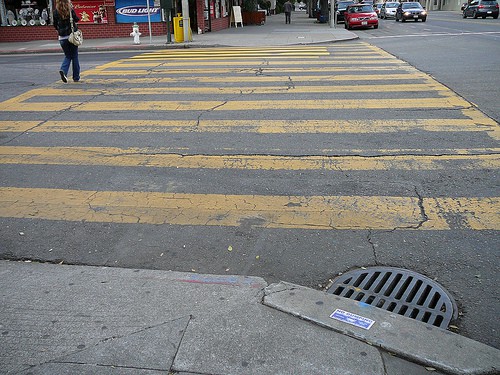 Crosswalks are those stretches of pavement (and sometimes paint) that make our cities walkable. Did you know:
Crosswalks are those stretches of pavement (and sometimes paint) that make our cities walkable. Did you know:
- Any time a sidewalk ends, whether it is at an intersection or in the middle of a block, the extension of that sidewalk into the street is a legal crosswalk?
- Many legal crosswalks are unmarked, especially in residential neighborhoods?
- A vehicle is required to stop whenever a person is in a crosswalk, marked or unmarked?
- Neighbors often approach the city to paint crosswalks, because a painted crosswalk is more visible to drivers, increasing the safety of people that walk?
Most California marked crosswalks are painted in one of four ways, in order of increasing visibility: two white lines, white lines with a perpendicular “hash marks,” two yellow lines and yellow lines with perpendicular hash marks.
The idea is that the more people use the crosswalk, or the more dangerous the crosswalk is deemed, the crosswalk should be more visible.
There are even more visible kinds of crosswalks, called diagonal crosswalks. Check out this one from Chinatown in Oakland.

Sometimes called “scrambles”, these crosswalks are highly visible because cars don’t always expect them. In an area like Chinatown with a lot of pedestrians, the traffic lights are changed to add an all-pedestrian phase.
The lights go: north-south cars, east-west cars, then people in every direction!
You can see where the name “scramble” comes from, right?
At any intersection, even if you as a pedestrian have the right-of-way (which you do), always look out for cars. Not everyone knows, or respects, the rights of pedestrians. Safety first!
